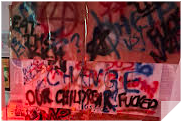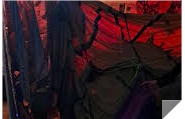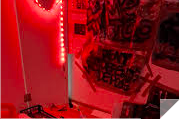This Wednesday and Thursday, year 12 students created 4 artistic installations for their Theory of Knowledge lesson led by Ms. Anniek. Their task was to create an artistic exhibit or experience students could participate in, that would shift people away from their anthropocene view of our world. The main concept was transforming and widening people’s perspectives from human centered, to zoomorphic (animal or insect centered), this way allowing them to understand the value of other beings in the world. In their works that were previously inspired by biomimicry, anthropocene and the post-anthropocene, students let their creativity flow to create their own immersive museum exhibit incorporating arts and sciences.
Volte Vida
By: Olga, Raia, Sara, Uma, Zoya

Volte Vida is a three-dimensional experience that submerges the audience into an unprecedented zoomorphic perspective, shifting away from the anthropocentrism that humans tend to employ in order to explore the impact of human activity on other living organisms. Divided into three stages: the Danger Zone; a chaotic, hostile work shaped by human destruction, the Womb; a fleeting refuge of safety and creation, and the Microscopic Realm; a world of bacteria and unseen life, the installation reverses the life cycle, immersing participants in the harsh realities of the world we live in. As they navigate this journey, the experience highlights the consequences of human dominance, urging reflection on how species feel, adapt, survive or disappear in the face of relentless environmental destruction. If the smallest life forms continue to persist beyond others, what does that reveal about the balance of nature?


Homo Rodentia: Labyrinth of Man
By: Andrey, Martin, Nikola, Uygar
In Homo Rodentia: Labyrinth of Man, participants step into the mind of a rat, experiencing the world from a non-anthropogenic perspective potentially for the first time. Just like their rodent counterparts in scientific experiments, they must navigate a complex maze filled with twists, turns, and unexpected obstacles. Every misstep triggers a sharp, jarring noise, simulating the conditioned responses studied in behavioral research. As they progress, participants will grapple with instinct, problem-solving, and the psychological effects of confinement and repetition. This experiment is based on the harsh reality that rats in laboratories are often subjected to stressful, unnatural conditions for the sake of human research. They are conditioned through fear-based learning, all without choice or understanding. By stepping into their world, participants can reflect on the ethical concerns of animal experimentation and question how we treat other species in the pursuit of knowledge.
The American behavioral psychologist Robert Tryon believed that genetic, rather than environmental, differences produced individual behavioral variations. This contrasted with the general opinion of that time. To prove his hypothesis, Tryon created an experiment that tested the proficiency of successive generations of rats in completing a maze. He exposed a genetically diverse group of rats to the maze, labeling those who made the fewest errors “bright”, and those with the most errors “dull”. The conclusion mostly confirmed Tryon’s assumption, but left details to interpretation.
What you see is a scaled maze used for the aforementioned rat experiments. It is adapted to human dimensions and has only one right path to the exit. Every time a participant makes a wrong turn, there is a sudden light flash and a loud, unpleasant noise to cause a stimulus-response effect similar to the fear-conditioning techniques used in laboratory settings. As participants navigate the maze, they are confronted with the repetitive, stress-inducing environment that countless lab animals endure daily. After completing Homo Rodentia: Labyrinth of Man, a participant wonders: Were my choices truly my own, or was I merely reacting to external forces, like the lab rats I was meant to embody? Moreover, If a brief time in a structured, conditioned environment could alter my behavior, what does that say about the systems—scientific, social, or otherwise—that quietly shape human decisions every day?
The world of a bat
By: Anna, Maral, Maj, Polina
In this simulation, we recreate bats’ experiences by darkening the entire room and filling it with the sounds of their prey and predators played through devices. The result is an exploration of perception beyond human senses. Bats can hunt in complete darkness solely based on their highly developed hearing abilities.
This experiment is based on echolocation, a natural skill used by bats, dolphins, and some birds. By analyzing the returning echoes, bats are able to detect objects, measure distances, and even differentiate textures in complete darkness. This sense of theirs is thoroughly studied in fields like sensory biology and robotics and has inspired technological advancements in navigation systems. The purpose of our design is to place us within this principle, shifting our priority away from our sight sense and toward sound. Though facing limitations, we aim to help humans experience the perceptual world of a nocturnal animal, bats.
The room is designed to act as an abstract cave, the flickers of sound replacing our usual reliance on vision. In this environment, we are forced to rely on subtle sound cues just like bats do every night. The lack of light almost disables our sense of space, urging us to listen, to feel the invisible walls of sound that form our temporary, sensory-dependent world.
After finding out that bats construct their understanding of the world through echoes, you might be wondering: how much of our own perception is an interpretation of the signals around us? Are there any dimensions that remain undiscovered simply because we lack the senses to perceive them?
By: Elena, Elina, Kristina, Sofya
